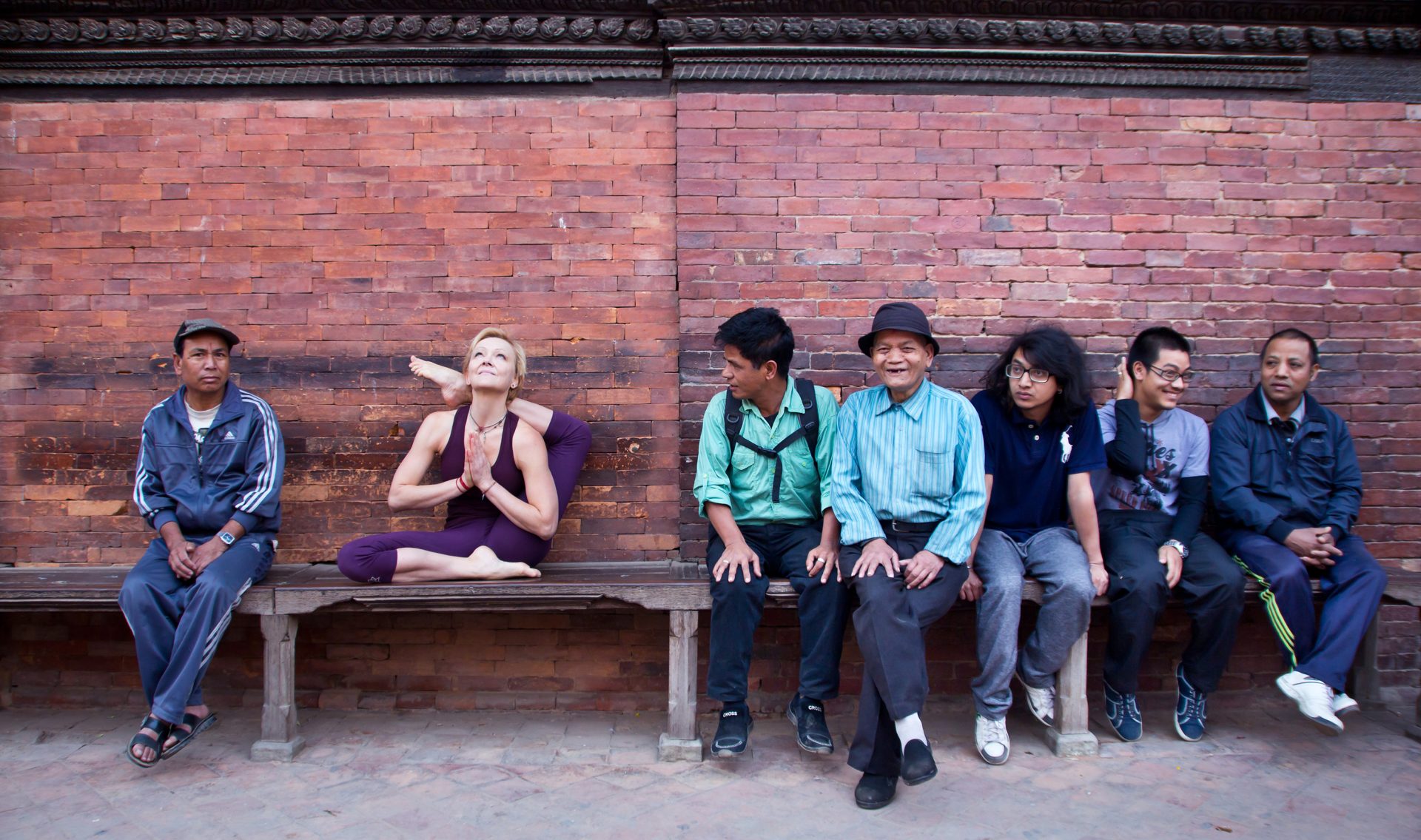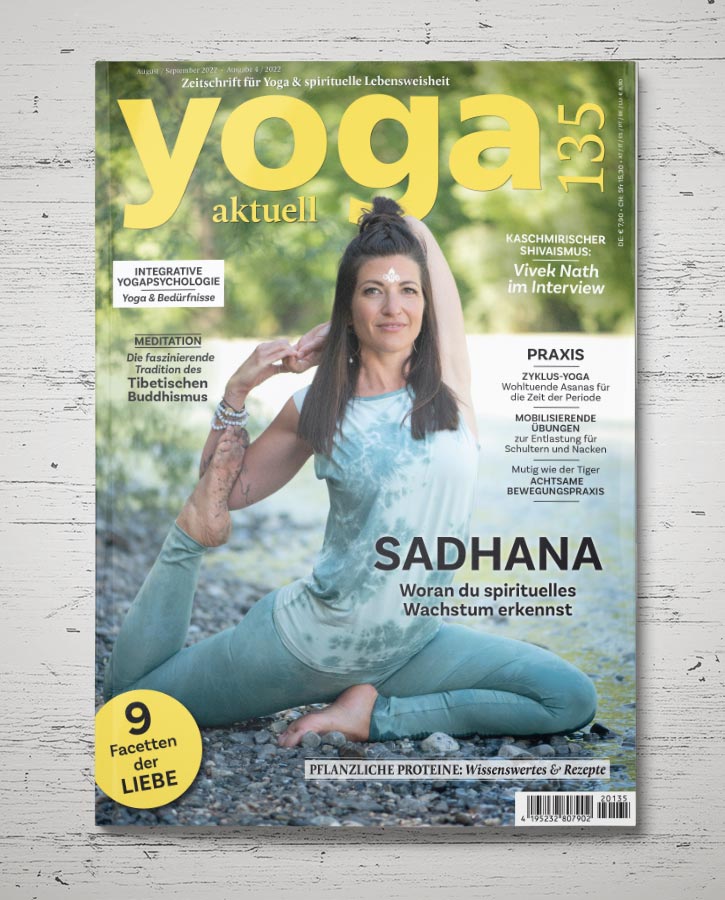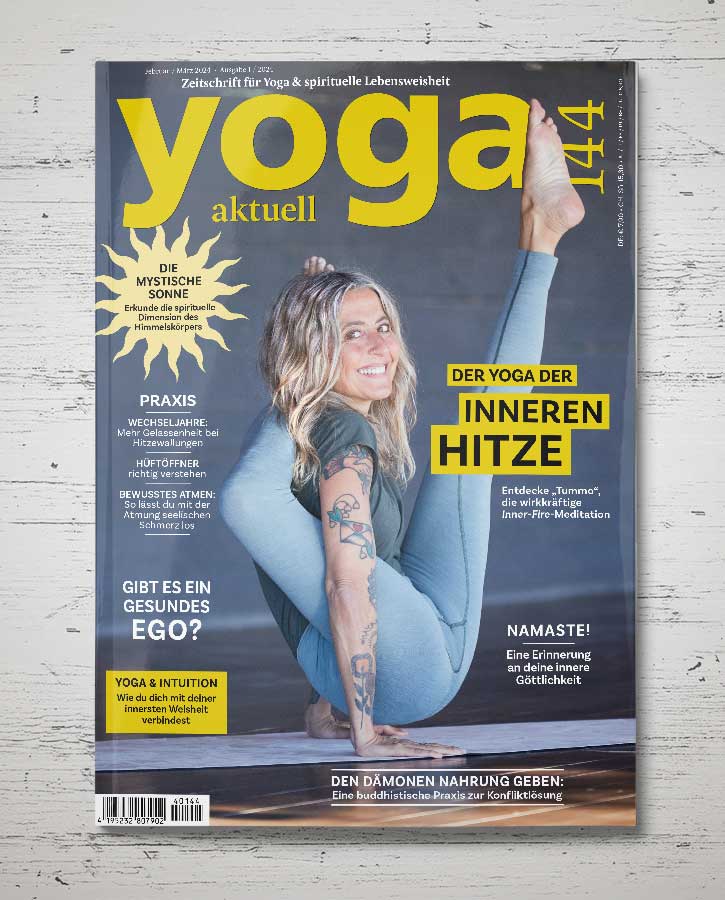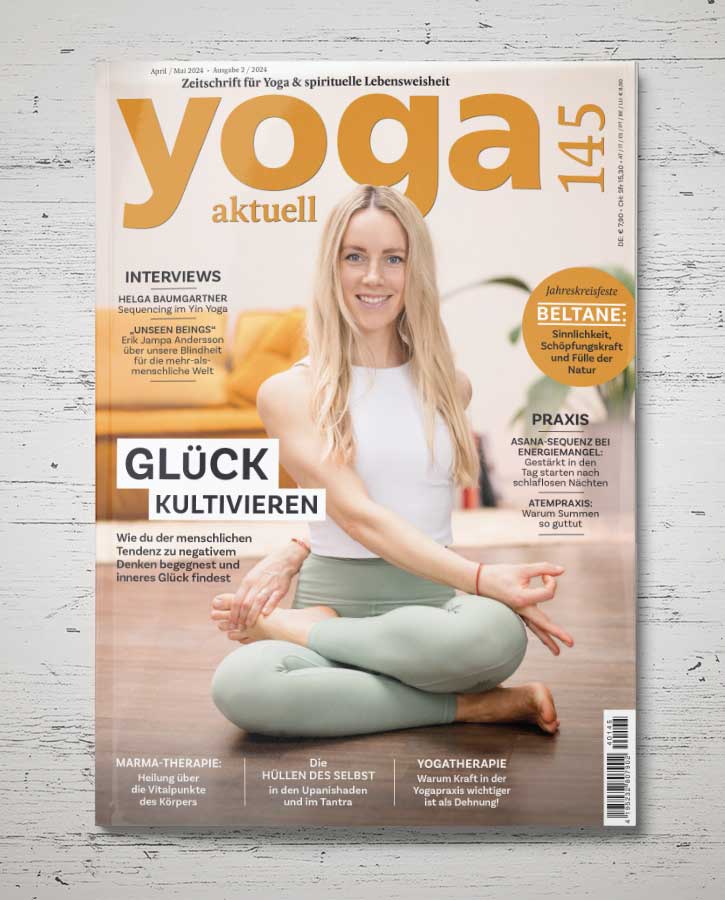Ashtanga Yoga Teacher Ellen Johannesen teaches in the touristic area of Kathmandu, in Thamel and studies at the Kathmandu University Centre for Buddhist Studies at Rangjung Yeshe Institute. We met her in her beloved adopted home Nepal and enjoyed an enlightening conversation with her on the connections between Yoga and Buddhism.
(If you like to read this interview in German, click here)
In the upcoming issue of YOGA AKTUELL No 122 you’ll find an Interview with Ellen in which she talks about her experiences with the practice of Buddhism. In the meantime, we wanted to share with you this other part of the conversation, we had with Ellen, in which the focus is on the yogic aspects.
You can’t always do the meditation and it’s kind of useless to do the meditation unless you have really studied and contemplated. Because if you want to change your mind you have to be convinced that you’re doing the right thing, that it’s possible.
Interview
YOGA AKTUELL: Let’s start with the beginnings: How did your Yoga Journey begin and evolve?
Ellen Johannesen: I am originally from Norway. My background was in contemporary dance and 1994 I discovered Ashtanga Yoga and from then on it was Dance and Yoga, then eventually it was only Yoga and I opened the first Mysore Studio in Oslo and started travelling to India and eventually I ended up in Nepal studying Tibetan Language and Tibetan Buddhism. But all the way the Ashtanga Yoga practice has been with me all the time. I am still in Kathmandu, were I’ve been for the last 8 years. I am running a Mysore program here and I am teaching retreats and workshops around the Kathmandu Valley as well and I also teach internationally. I like to teach a combination of Ashtanga Yoga but also give people an insight in the spiritual practices that are going on in the Valley where you have really a variety of Buddhist practices and Hindu practices but you also have the special Newari culture that is unique to the Kathmandu Valley. So, I like not just to teach people Buddhist philosophy or Yoga philosophy but also see how that plays out in peoples daily lives and practices.
Here in Kathmandu you mostly teach to foreigners, or are local people also coming to your classes?
It’s a variety and now I am very happy, that I get more Nepali students actually in my classes. You have all kind of Nepalis. Of course for the common Nepalis, going to a Yoga studio is too expensive, even though my classes are not expensive (laughs), it’s too expensive and maybe also a foreign idea to them but there are also Nepalis, who are educated abroad or some are western oriented or they are just more well off, and for them of course Yoga is also a popular thing. So I have more Nepalis coming, there are expats here, who work for NGOs and embassies and there are of course travellers coming and also, what happens which is really nice, that people come to stay for a month and practice yoga and focus on yoga, like the Chinese girls I have in my class they are returners, they have been here before and they’ve stayed for a month and they realized they can learn a lot because we are a small community here.
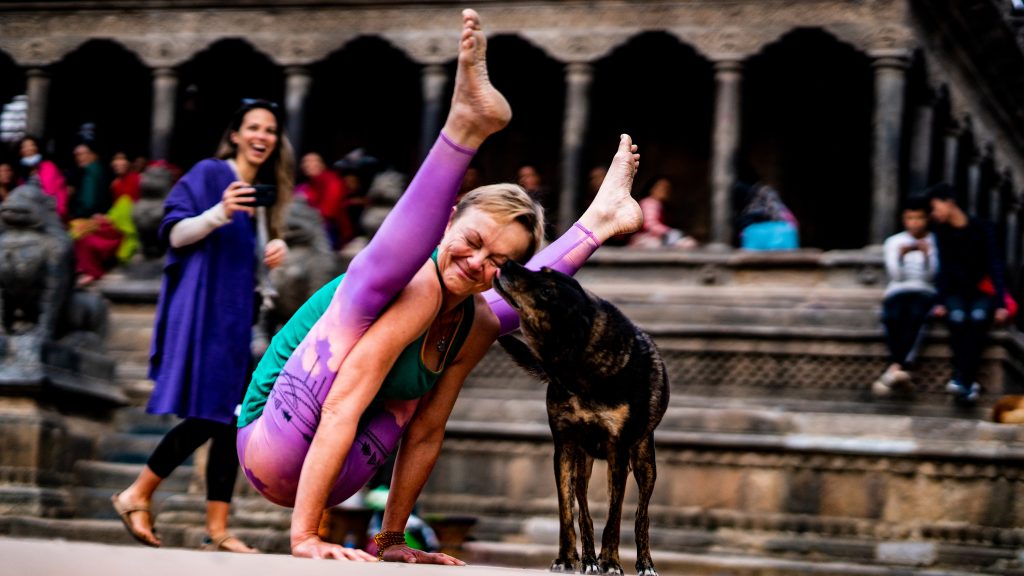
Lets go back to when you started. You started in New York with David Life?
Yes, at that time they had Ashtanga Yoga even at the Jivamukti School, so I started there. I went to all their classes, but for me I thought since Ashtanga is a kind of linear development, its the same routine, I thought this is what I will take home from New York because this was easier for me to remember. So I just started teaching to my friends and collegues.
How come you ended up being a student of John Scott. Where did you meet him?
I went to a retreat with him. There was no Ashtanga Yoga in Norway at that time so I started going to retreats abroad. So, I went to retreat with John Scott and I really liked his way of teaching, it’s very in line with my experiences as a contemporary dancer. It’s very functional. As a contemporary dancer I am not into doing a pose just for the sole purpose that it looks aesthetic, like you should always keep your knees that straight or something – that is not always very functional, right. If you need, to go into a pose, lower your center of gravity, relax your joints, exhale, go in – and then extend. So, there is a functional part to it that John Scott teaches that I really liked. He is very systematic in how he teaches Adjustments, so I ended up doing a two-year Teacher Training – in the good old days the Teacher Trainings were very long and very thorough, so this was a longer one. And I learned a lot and I still use his principles. I trust his principles really.
I’ve read it was John Scott, who inspired you to go to Mysore?
Yes, well I have already been in Mysore before and I wasn’t so impressed. I mean, I thought Guru-ji (Patthabi Jois, editor’s note) was a sweet man, but at that time there was a lot of waiting. We were like 70 people and the studio could only take 12, so we had to sit around and wait for 1 hour and a half… It was a good practice, but I was actually mostly impressed with the yoga philosophy that I learned in India and from BEING in India. I thought, this is really the place, where the spiritual culture is alive and I was very impressed with this whole idea of Karma and be mindful of what you’re doing and think in terms of not just this life, you know, this whole way of living, the way of thinking about your life, thinking about your responsibilities, thinking about your actions, trying to improve as a human being. That was very attractive to me.
But you turned more to Buddhism, not to Hinduism. How come?
That was actually when I returned to India again. I got in contact with some Buddhists there, western Buddhists, and I started studying the philosophy and to me I found that this was very applicable. There’s so many methods, that you can apply. I think, what I found in the eastern philosophies that you have is, that the philosophy is very appealing, but: how do you practice? How does it make an impact on your life? In Buddhism that is very detailed: you do all these things that we call Mind Training to change your view, to think in a more altruistic way, to change your perception of the world, of your surrounding and of yourself and of other beings. So it’s really a way of training in your connectedness to all other living beings and to behave in a way that you treat them with kindness and compassion.
So, Buddhism impressed you so much that you even went to live in a Monastery. What was your intention? Did you plan on becoming a nun?
(laughs) No, I never planned on becoming a nun. I met this extremely charismatic teacher and it was his idea. I didn’t actually plan on going to a monastery. I just thought he would give me some practices that I could do at home. But he said, “No, come to a monastery!” Ok, so I went. For me it was great to just live there and to see how people live. To see, what kind of community is it, when everybody is working towards the same aim and when they are trained in this Mind Training and when they are doing the rituals. They are different from other people. They are not running around chasing girlfriends and stuff, that most young guys do. They have different kind of lifes. And they have to be both – masculine and feminine, because there was a lot of kids in the monastery. So, to me it was just nice to be around them. They were very balanced, they never raised their voice … of course there are all kinds of people, but I just found them really very nice and kind to be around.
It was only monks and you were the only woman?
Yes. We were 3 westerners there. Although I didn’t live WITH the monks – I lived in a Guesthouse. But of course, I moved around the Monastery and we were helping out a little bit, taking care of the kids, we had a little clinic for them – not that I am a nurse bit I can put on a band aid and pat them on the head and make them feel better. And just observing the way of life I thought was very good. And of course, I had my Ashtanga practice, I studied Tibetan language, it was a good time. But overall, I didn’t understand so much about of what was going on. Because it was like a lot of tantric rituals and stuff that they were doing – long pujas. So, in the end I thought, well I think I have to study Buddhism in a more structured way and also learn the language in a more structured way. So I decided to join the University here in Kathmandu.
You decided to come to Kathmandu for the University?
Yes, they have a pretty amazing University here, the Rangjung Yeshe Institute, that is actually in a Monastery, so it wasn’t such a big swop for me, cause I can still be in the Monastery, you don’t live in the Monastery but suddenly you study there, so half of your classes will be with monks, with lopons (junior monastic professors) and khenpos (senior monastic professors), with highly educated monks, they will teach you in a very traditional way. And when I came from the Monastery I was so hungry for that. Because I had lived there and I couldn’t understand what was going on and nobody had explained me. So, I really wanted to study when I got here. So, I just soaked up everything.
But also, during this time in the Monastery did you never feel drawn to an ascetic kind of life?
It was a kind of ascetic life in the Monastery. I had a small room and it was very simple. Sometimes we didn’t have electricity, sometimes we didn’t have water for days. And I didn’t go out so much. Because I was told to sit in my room and recite prayers and study. So in a way it was kind of an ascetic life to life there. And I think I’ve always had this kind of romantic idea of ascetics that one day I will sit in a cave and just be a Yogi. And actually Kathmandu is a place where people do exactly that. Maybe you don’t sit in a cave, but there are also caves you can sit in, actually… A lot of practitioners that I know, they regularly go into retreat for a month or more, sometimes for a year – that’s kind of extreme, but they actually do that. They isolate themselves and just sit and practice for months and months so that’s also an opportunity you have here in Nepal.
They do that on their own?
You have a kind of support system here. There are retreat centers where you can go. Where you are given you room and they serve you food so you don’t have to think about worldly things like shopping and cooking. You can get the food on your door 3 times a day. So there are people doing that here.
How do you balance? I think that’s often a hard part, like sometimes I am drawn to just sit and meditate – I don’t want to engage with all these things, and then other times, I just want to do it all and have no time for practice.
That was a real struggle for me, especially when I was in school because the work load was so enormous. So, my mind was never relaxed because there was always a term paper, there was always hundreds of pages more that I had to read. So, the only way to go about it is to think, that this learning is actually my practice right now, turn the learning into the practice and realize that what you are studying is sacred texts and read them in a sacred way. In Buddhism we actually say that there are 3 parts to practicing Buddhism. It’s the listening and learning, it’s the contemplation and it’s the meditation. You can’t always do the meditation and it’s kind of useless to do the meditation unless you have really studied and contemplated. Because if you want to change your mind you have to be convinced that you’re doing the right thing, that it’s possible. So, then you have to study the philosophy for that and then you realize it through your practice.
Thank you very much for this Interview!
Read more:
If you want to know more about Ellens Buddhist practice and Buddhism overall, read the rest of our conversation with Ellen in YOGA AKTUELL No 122, which was released June 1st and is available in our onlineshop.


